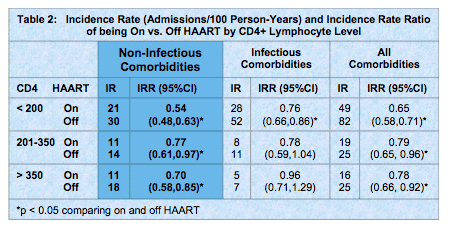 |
 |
 |
| |
Lower Noninfectious Disease Rates With HAART in All CD4 Brackets
|
| |
| |
(Poster online at http://www.retroconference.org/2008/PDFs/963.pdf.)
15th Conference on Retroviruses and Opportunistic Infections
February 3-6, 2008
Boston
Mark Mascolini
Rates of serious noninfectious maladies-including neurologic, pulmonary, and heart disease-were lower among Johns Hopkins cohort members taking antiretrovirals than among untreated people in all CD4 brackets, including more than 350 cells [1]. The Hopkins team believes their findings suggest antiretroviral therapy in people with more than 350 CD4 cells may lower the risk of these noninfectious diseases.
When the SMART treatment interruption trial found higher rates of liver, kidney, and heart disease in people randomized to the drug-holiday group [2], concern grew that HIV-infected people not taking antiretrovirals ran a higher risk of some non-AIDS diseases than treated people. To analyze rates of infectious and noninfectious morbidity in people on and off antiretroviral therapy, Richard Moore and Hopkins colleagues sifted hospital admission data on 2317 people enrolled in their cohort from 1996 to 2004 and monitored for an average 3.9 years through June 2006.
During follow-up Hopkins cohort members landed in the hospital 3229 times, 1331 times for infectious diseases and 1898 times for noninfectious diseases. Moore did not count admissions for trauma or obstetrics. Neurologic and psychiatric admissions accounted for a quarter of noninfectious admissions, followed by noninfectious pulmonary diseases, heart disease, and metabolic or endocrine disorders:
· Neurologic/psychiatric: 479 of 1898 noninfectious admissions (25.2%)
· Noninfectious pulmonary: 291 of 1898 noninfectious admissions (15.3%)
· Cardiovascular: 254 of 1898 noninfectious admissions (13.4%)
· Metabolic/endocrine: 239 of 1898 noninfectious admissions (12.6%)
· Gastrointestinal/liver: 234 of 1898 noninfectious admissions (12.3%)
· Renal: 172 of 1898 noninfectious admissions (9.1%)
· Non-AIDS malignancy: 133 of 1898 noninfectious admissions (7.0%)
· Others: 96 of 1898 noninfectious admissions (5.1%)
Incidence of noninfectious diseases proved lower for people on versus off antiretrovirals in every CD4 stratum analyzed: 21 versus 30 admissions per 100 person-years for fewer than 200 cells, 11 versus 14 for 201 to 350 cells, and 11 versus 18 for more than 350 cells. These rates translated into:
· A 46% lower risk of a noninfectious admission below 200 CD4s (incidence rate ratio [IRR] 0.54, 95% confidence interval [CI] 0.48 to 0.63, P < 0.05)
· A 23% lower risk of noninfectious admission from 201 to 350 CD4s (IRR 0.77, 95% CI 0.61 to 0.97, P < 0.05)
· A 30% lower risk of noninfectious admission above 350 CD4s (IRR 0.70, 95% CI 0.58 to 0.85, P < 0.05)
Among people with CD4 counts under 200, Hopkins investigators counted 52 admissions for infectious causes in people taking antiretrovirals versus 28 in people not taking antiretrovirals to yield almost a 25% lower risk of admission for an infectious disease in people on treatment (IRR 0.76, 95% CI 0.66 to 0.86, P < 0.05). But admission rates for infectious diseases did not vary significantly between people off and on therapy at higher CD4 counts. In this cohort admissions for infectious diseases at CD4 counts above 200 mainly reflected problems resulting from drug abuse.
Moore and colleagues concluded that hospital admissions for both infectious and noninfectious causes remained common in their cohort through 2006, but noninfectious illnesses sent more people to the hospital than infectious diagnoses. Risks of infectious diseases and of infectious and noninfectious diseases combined were significantly lower among people taking antiretrovirals.

References
1. Moore R, Gebo K, Lucas G, Keruly J. Non-AIDS co-morbidities by CD4 level and HAART use in clinical practice. 15th Conference on Retroviruses and Opportunistic Infections. February 3-6, 2008. Boston. Abstract 963.
2. Strategies for Management of Antiretroviral Therapy (SMART) Study Group, El-Sadr WM, Lundgren JD, Neaton JD, et al. CD4+ count-guided interruption of antiretroviral treatment. N Engl J Med. 2006;355:2283-2296.
|
| |
|
 |
 |
|
|